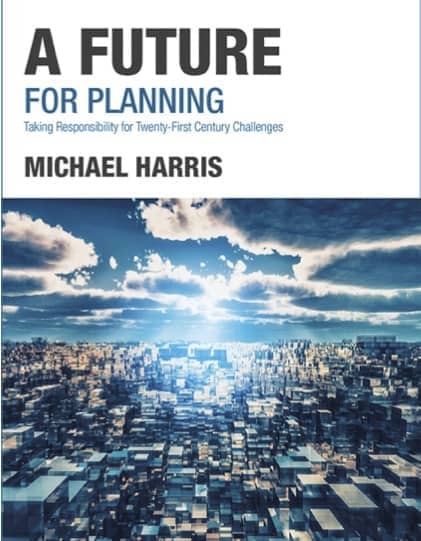
www.buildingsandcities.org/insights/reviews/future-for-planning-review.html
A Future for Planning: Taking Responsibility for Twenty-First Century Challenges
By Michael Harris. Routledge, 2019, ISBN: 9781138708808
Gerald Mills reviews this book on how planning theory and practice have changed, and whether they are equipped to tackle the challenges of climate change.
This book is based on a series of papers that were published to recognize the 100th anniversary of the foundation of the Royal Town Planning Institute (RTPI) which is a Chartered Institute that accredits planning courses nationally and internationally and maintains professional standards. The series was entitled 'Planning Horizons' and focused on the evolving status of planning (as an idea and practice) in the UK and how it has changed over the last century. The premise of the book is that repeated ideological attacks on planning theory and practice have left it ill-prepared to deal with the climate crisis and the comprehensive response that is needed.
The structure of the book is divided into two parts. The first part is devoted to a historical analysis of the changing status, roles and influence of planning since the beginning of the 20th century. While the focus of this part is on the UK, the influences on planning as a profession are common in western societies characterized by neo-liberal approaches to public services. This section analyses the causes of the crisis in planning, and makes the case for a new progressive planning to cope with global environmental challenges, notably climate change. The second part of the book provides international case-studies that demonstrate how integrated, long-term and inclusive planning can address these challenges. As the author writes:
This book is not a 'how to' plan for the future… Rather it is about how, despite uncertainties, it is possible to plan, contrary to a widespread planning pessimism that has been promoted by some of the fiercest and most determined opponents of planning, particularly neoliberals. It is a critical defence of the idea of planning, especially planning for the long-term
The first part of the book comprises five chapters on how official planning has changed from its beginnings as a profession that was expert-led and focused on the management of land-uses for the improvement of society. The diminution of its standing and ability to plan is attributed to the rise of the New Right, which characterized planning practice as authoritarian, inefficient and based on the false premise that one could predict the future. Inspired by the economics of Friedrich Hayek, they argued for market-led development as the only rational basis for land-use management. It follows that interference in this process for longer term societal benefit, broadly defined, could not be justified based on expert insights. The success of this perspective has made planning policy and practice short-sighted, limited in scope and ambition and incapable of dealing with long-term and knowable threats, such as those associated with climate change. To illustrate these points, the author initially draws on a diverse set of planning failures such as the financial crisis of 2008 but then shifts to evolving responses to attacks by the New Right (and left) in urban and regional planning.
As the author states:
The story of post-war planning presented here, focusing on the UK but echoed in many other countries, is from certainty to uncertainty, from popular political visions of a better society and a confidence in how this could be achieved, to increasing external and internal criticism and self-doubt. This has resulted in a lack of political and public visibility and confidence in planning, and a widespread short-termism which leaves us largely unprepared for the future we now face.
The second part of the book consists of two chapters that present cases studies that have been selected to illustrate different points: that we have enough knowledge of the future to act; that decision-making systems must take an integrated and longer-term perspective and; that citizen engagement is necessary to build public support. The case studies include: Rotterdam and its history of water management; New York and its sustainability plan (PlaNYC/OneNYC) that is both integrated and responds to climate change projections; Singapore and its use of scenario-based approaches to plan for the future; Seychelles and its use of public participation; Germany and its restructuring of the energy system (Energiewende) to allow citizen energy production and; community-led strategies based on local actions. The final chapter of the book has the subtitle 'Planning for the Long Term in an Age of Crisis and Short-Termism', which summarizes the case for renewal of planning practice.
The diagnosis presented by the author for the state of planning is coherent and the need for a long-term perspective to address the major issue of our times is compelling. Clearly, the short-term thinking associated with, and advocated by, the New Right perspective is not capable of dealing with the multi-scalar decisions needed to deal with climate change; in fact, one could argue that it has accentuated the drivers and enhanced the risks through land-use management. I do think that part of the difficulty associated with planning for climate change is that the scale of the problem is vast and that the integrated approach needed to address climate change is so comprehensive that it affects all aspects of 'developed' societies. In the examples presented in the book, it would have been helpful to use environmental case-studies to bolster the arguments for progressive planning. For example, climate change is driven by the emission of greenhouse gases which are not generally seen as air pollutants that affect people's health (and are not measured as such). By comparison, there are well established systems for managing local air quality based on observations, understanding and responses. The latter include land-use zoning, technological controls and behaviour modification many of which are equally applicable to managing emissions associated with climate change. The difference is that air quality can be directly related to public health in the short-term and is often readily detectable by sight or smell. At a different scale, ozone depletion is probably regarded as an exemplar of global environmental management, which was led by scientific evidence that was quite complex. The solution (banning a class of manufactured chemicals) was relatively easy in that it required inter-governmental co-operation with limited citizen participation. So, dealing with climate change that challenges the foundation of modern economies that are connected by the transfer of resources over global scales is a different order of problem.
One issue that could have been given more prominence in the book is the issue of scale of action, which is implied in the case-study examples but could be made explicit. One of the problems with overcoming the 'fatalism' associated with climate change and the difficulty in getting people to accept a long-term view is that the actions and consequences are not strongly connected and that actions by individuals, communities and countries can be undermined by those of others. So, we need a planning toolkit that can both accommodate place-making at local scales and place these decisions in the context of regional and global changes. The case-studies in the book provide examples of techniques that can build participatory frameworks to address this issue. A Future for Planning was published just before the Covid pandemic; it would have been interesting to hear the author's take on its management in the context of greatly restricted movements of people and the renewed interest in the neighbourhood and the local environment that emerged.
As a physical geographer and non-expert in the planning field, I found A Future for Planning to be an insightful and provocative read and challenged my views on the prospects and challenges for planning for climate change. I was especially taken by the challenge presented to academics to provide direction and leadership on the planning that is needed for coping with the challenges we face and to provide solutions for planning practice. I teach courses on climate change and the urban environment at my home university and I will be modifying several of my lectures to incorporate the ideas introduced in this book.
Latest Peer-Reviewed Journal Content
Designing for pro-environmental behaviour change: the aspiration–reality gap
J Simpson & J Uttley
Lifetimes of demolished buildings in US and European cities
J Berglund-Brown, I Dobie, J Hewitt, C De Wolf & J Ochsendorf
Expanding the framework of urban living labs using grassroots methods
T Ahmed, I Delsante & L Migliavacca
Youth engagement in urban living labs: tools, methods and pedagogies
N Charalambous, C Panayi, C Mady, T Augustinčić & D Berc
Co-creating urban transformation: a stakeholder analysis for Germany’s heat transition
P Heger, C Bieber, M Hendawy & A Shooshtari
Placemaking living lab: creating resilient social and spatial infrastructures
M Dodd, N Madabhushi & R Lees
Church pipe organs: historical tuning records as indoor environmental evidence
B Bingley, A Knight & Y Xing
A framework for 1.5°C-aligned GHG budgets in architecture
G Betti, I Spaar, D Bachmann, A Jerosch-Herold, E Kühner, R Yang, K Avhad & S Sinning
Net zero retrofit of the building stock [editorial]
D Godoy-Shimizu & P Steadman
Co-learning in living labs: nurturing civic agency and resilience
A Belfield
The importance of multi-roles and code-switching in living labs
H Noller & A Tarik
Researchers’ shifting roles in living labs for knowledge co-production
C-C Dobre & G Faldi
Increasing civic resilience in urban living labs: city authorities’ roles
E Alatalo, M Laine & M Kyrönviita
Co-curation as civic practice in community engagement
Z Li, M Sunikka-Blank, R Purohit & F Samuel
Preserving buildings: emission reductions from circular economy strategies in Austria
N Alaux, V Kulmer, J Vogel & A Passer
Urban living labs: relationality between institutions and local circularity
P Palo, M Adelfio, J Lundin & E Brandão
Living labs: epistemic modelling, temporariness and land value
J Clossick, T Khonsari & U Steven
Co-creating interventions to prevent mosquito-borne disease transmission in hospitals
O Sloan Wood, E Lupenza, D M Agnello, J B Knudsen, M Msellem, K L Schiøler & F Saleh
Circularity at the neighbourhood scale: co-creative living lab lessons
J Honsa, A Versele, T Van de Kerckhove & C Piccardo
Positive energy districts and energy communities: how living labs create value
E Malakhatka, O Shafqat, A Sandoff & L Thuvander
Built environment governance and professionalism: the end of laissez-faire (again)
S Foxell
Co-creating justice in housing energy transitions through energy living labs
D Ricci, C Leiwakabessy, S van Wieringen, P de Koning & T Konstantinou
HVAC characterisation of existing Canadian buildings for decarbonisation retrofit identification
J Adebisi & J J McArthur
Simulation and the building performance gap [editorial]
M Donn
Developing criteria for effective building-sector commitments in nationally determined contributions
P Graham, K McFarlane & M Taheri
Join Our Community

The most important part of any journal is our people – readers, authors, reviewers, editorial board members and editors. You are cordially invited to join our community by joining our mailing list. We send out occasional emails about the journal – calls for papers, special issues, events and more.
We will not share your email with third parties. Read more



Latest Commentaries
COP30 Report
Matti Kuittinen (Aalto University) reflects on his experience of attending the 2025 UN Conference of the Parties in Belém, Brazil. The roadmaps and commitments failed to deliver the objectives of the 2025 Paris Agreement. However, 2 countries - Japan and Senegal - announced they are creating roadmaps to decarbonise their buildings. An international group of government ministers put housing on the agenda - specifying the need for reduced carbon and energy use along with affordability, quality and climate resilience.
Building-Related Research: New Context, New Challenges
Raymond J. Cole (University of British Columbia) reflects on the key challenges raised in the 34 commissioned essays for Buildings & Cities 5th anniversary. Not only are key research issues identified, but the consequences of changing contexts for conducting research and tailoring its influence on society are highlighted as key areas of action.